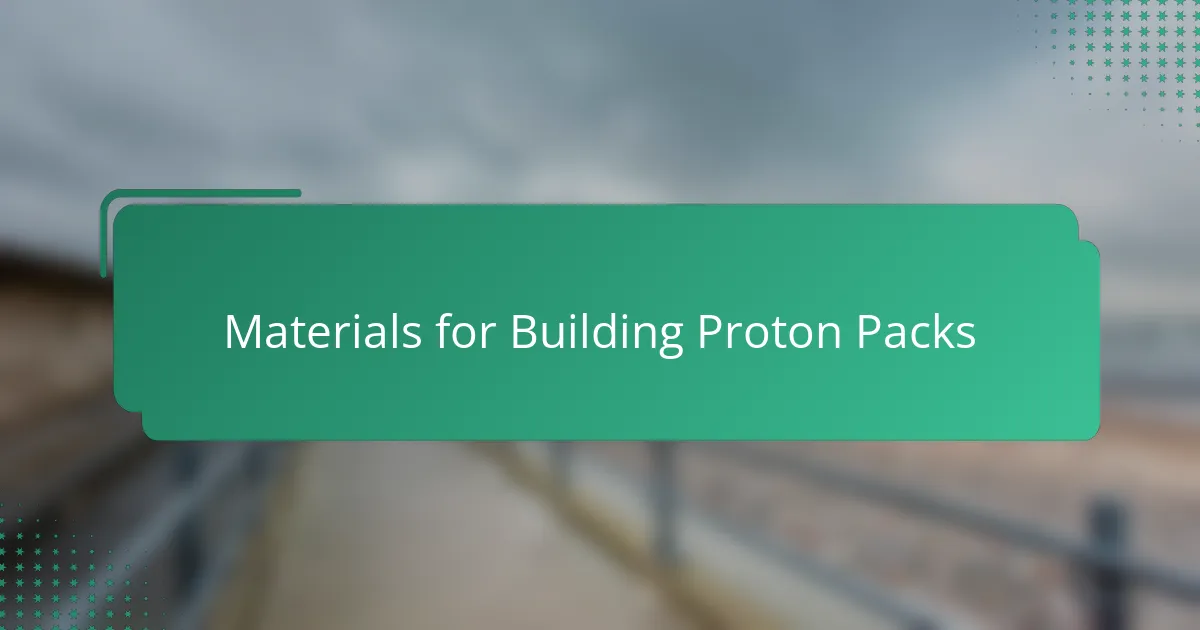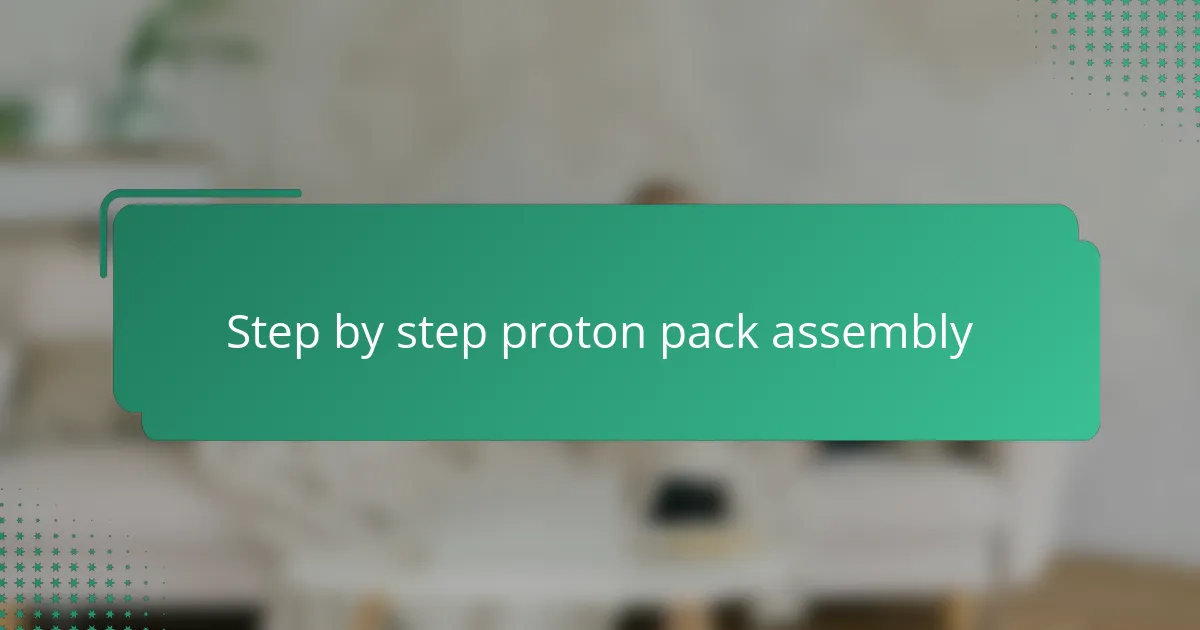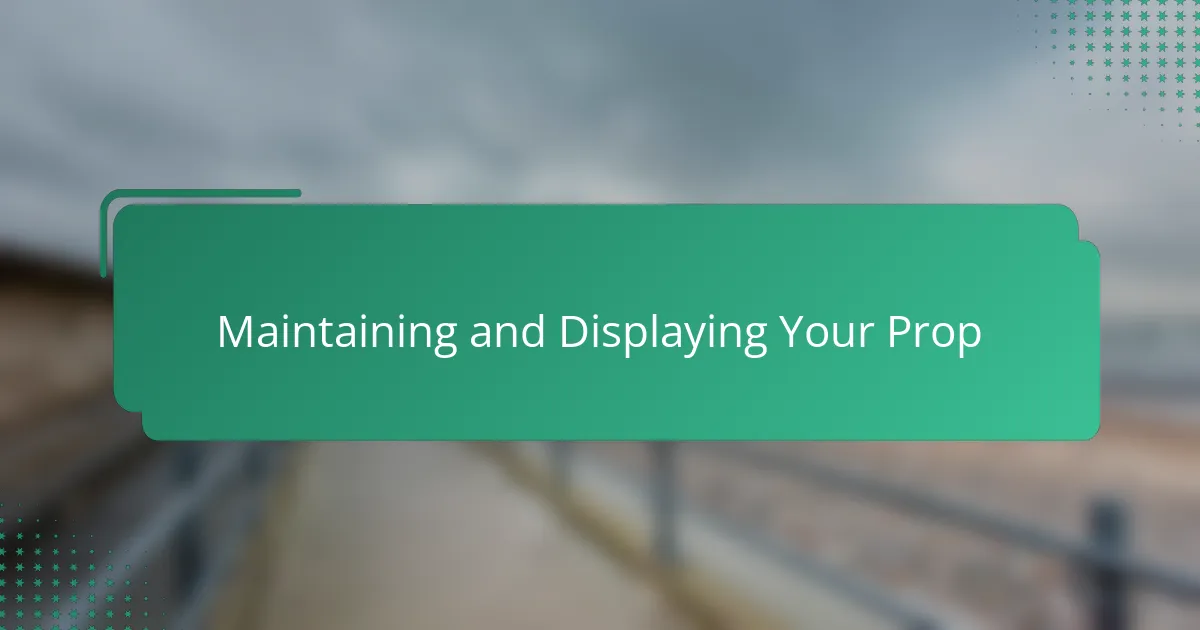Key takeaways
- Science fiction props connect imagination and reality, evolving from practical effects to digital enhancements, enriching our experience of the stories they represent.
- Essential tools for prop assembly, like soldering irons and digital multimeters, are crucial for precision and functionality, significantly impacting the assembly process.
- The choice of materials affects both the prop’s appearance and emotional connection, with layering different textures enhancing the realism of builds like proton packs.
- Maintaining and displaying props thoughtfully can elevate their significance, turning them into cherished conversation pieces while preserving their condition over time.

Overview of Science Fiction Props
Science fiction props have always fascinated me because they blur the line between imagination and reality. These objects—from futuristic gadgets to iconic weapons—are more than just movie elements; they are symbols of creativity and innovation that invite us to step into other worlds. Have you ever noticed how a well-crafted prop can instantly transport you to a different time or place, making the story feel tangible?
What I find truly captivating is how science fiction props evolve with technology. Early props relied heavily on practical effects and clever craftsmanship, while today’s creations often combine traditional techniques with digital enhancements. It makes me wonder how much deeper our connection to these fictional universes becomes when the props feel authentic, almost like real tools from another dimension.
In my experience, collecting or building science fiction props is like holding a piece of storytelling magic in your hands. Each detail, no matter how small, tells a story and sparks memories of adventures shared through film or literature. Isn’t that the real power of these objects? They let us relive the wonder and excitement of science fiction over and over again.

Essential Tools for Prop Assembly
When I first started assembling my Ghostbusters proton pack, I quickly realized that having the right tools was just as important as having accurate blueprints. Basic tools like a soldering iron, a good set of screwdrivers, and a hot glue gun became my best friends during the process. Without them, tiny parts would have felt impossible to secure and delicate wiring thrown together.
Sometimes, I underestimated how much precision mattered. A digital multimeter saved me from so many headaches by helping check electrical connections, making sure everything was safe and functional. It made me think: how often do we overlook the small tools that quietly make a project succeed behind the scenes?
And then there’s the joy of using clamps and tweezers to hold pieces steady while working. It might seem like a small detail, but those tools kept me from losing my patience when working with intricate parts. Have you ever tried balancing tiny wires without something to hold them? I’ll bet you’ll appreciate these essentials the moment you try assembling any prop.

Materials for Building Proton Packs
Gathering materials for my proton pack was like embarking on a treasure hunt, but the real prize was finding components that felt authentic yet manageable. I wanted to strike a balance between lightweight plastics and sturdy metals, so parts like PVC pipes and aluminum sheets became my go-to choices. Have you ever been surprised by how everyday materials—like foam or acrylic—can transform into futuristic gear with just a bit of creativity?
One challenge I encountered was sourcing the right electronic components to mimic the proton pack’s iconic lights and sounds. Small LEDs, wires, and battery packs might seem simple, but picking the right voltage and durability made all the difference in making the prop feel alive. It made me realize that the materials aren’t just about looks; they’re crucial for capturing that immersive, high-tech vibe.
What stood out to me was how layering different textures—glossy plastic, matte tape, metal mesh—added depth and realism to the pack. The tactile experience, when holding and assembling these pieces, made the proton pack feel less like a model and more like an actual piece of Ghostbusters gear. Don’t underestimate how much materials shape not just appearance, but the entire build process and emotional connection.

Step by Step Proton Pack Assembly
Starting the proton pack assembly, I found it crucial to follow a step-by-step approach. First, I laid out all the components, organizing parts like the frame, cyclotron, and wand separately. Have you ever noticed how simply seeing everything neatly arranged makes the whole project feel more manageable and less overwhelming?
As I began attaching the frame components, I realized the importance of patience and precision. Using clamps to hold pieces in place while gluing or screwing them together saved me from frustration more than once. There’s something oddly satisfying about watching the pack take shape little by little, like piecing together a puzzle that’s also a piece of pop culture history.
Wiring the LEDs and power source was, without a doubt, the trickiest part for me. I double-checked every connection with my multimeter and took my time to neatly route each wire. It made me appreciate how vital attention to detail is—because when the lights finally blinked on, it felt like the pack truly came alive, making all the effort worth it. Have you experienced that moment when a complex build suddenly clicks into place? That feeling is priceless.

Common Challenges in Prop Making
Prop making often surprises me with how many small setbacks can pop up unexpectedly. Sometimes, pieces just don’t fit as perfectly as the blueprints suggest, and I’ve had to improvise or even rework entire sections. Have you ever felt that frustration when something you planned meticulously refuses to cooperate? I know I have, and it’s a test of patience and creativity.
Another challenge I keep running into is balancing durability with weight. Making a prop sturdy enough to handle wear but still light enough to carry around takes constant tweaking. I once made a pack so heavy that wearing it for more than five minutes felt like a workout, which taught me the hard way how important material choice really is.
Electronics add a whole new layer of complexity. Installing tiny LEDs and sound components isn’t just about plugging things in; it requires careful wiring and troubleshooting, and mistakes can be tricky to trace. I remember late nights hunched over my workbench, testing circuits and rewiring until everything lit up just right. It’s a rewarding challenge, but don’t underestimate how much time and patience it demands.

Personal Tips for Successful Assembly
One tip I swear by is to take your time with every connection and joint. Rushing through the assembly only led me to misaligned parts and extra frustration, so I learned early on that patience pays off. Have you ever had to redo something because it seemed easier to speed through? Trust me, slowing down will save you hours later.
Another thing that helped me was keeping the workspace organized—every screw, wire, and small piece had its own spot. When I stopped digging through piles of parts, the build felt less chaotic and more enjoyable. Isn’t it amazing how a tidy desk can clear your head and let creativity flow more freely?
Lastly, don’t underestimate the power of testing as you go. I made the mistake of waiting until the end to check the electronics, which meant hunting down issues in a tangled mess. Checking connections step-by-step kept surprises at bay and made the glowing lights at the finish line that much more satisfying. What’s your strategy for avoiding last-minute headaches? For me, it’s all about steady progress and constant double-checking.

Maintaining and Displaying Your Prop
Displaying my proton pack proudly meant thinking beyond just setting it on a shelf. I found that mounting it on a sturdy wall bracket not only showcased the intricate details but also kept it safe from accidental knocks. Have you ever noticed how a well-lit display can turn a prop from a mere object into a centerpiece that draws attention and sparks conversations?
Maintenance became a routine that, to me, felt almost like caring for a treasured collectible. Dusting it gently with a soft brush and checking connections regularly kept the LEDs shining bright and prevented wear. It’s surprising how little upkeep can preserve the magic, don’t you think?
Every now and then, I revisit the pack to tighten loose screws or touch up scuffs with paint. These small acts feel like rituals that keep the prop alive, reminding me of the journey it represents. Have you experienced that sense of pride when your handiwork not only looks great but continues to function perfectly, year after year?


